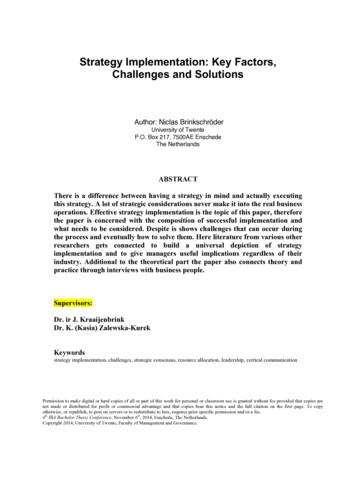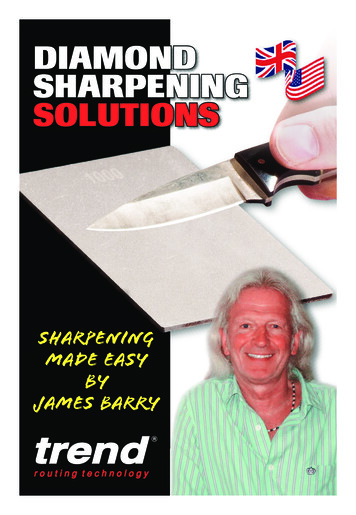
Transcription
DIAMONDSHARPENINGSOLUTIONSSharpeningMade easybyjames barry
James Barry has more than 25years experience in the diamondsharpening abrasive industry.From his home in Leicester,England, James has designed acomprehensive range of precisiondiamond sharpening products forTrend. He is widely regarded asone of the leading experts in thefield of diamond sharpening in theworld.He has travelled the worldextensively working withAmerican, Swiss and Japanesemanufacturers of diamond whetstones. Through this experience,he has gained a vast knowledge of sharpening techniques andsolutions to sharpening problems.James Barry’s Philosophy of Sharpening.“Maintaining your tooling yourself prolongs it’s life, improvesefficiency & saves money.Do not be frightened or wary of this new concept of in-housemaintenance, you can do it yourself.Businesses, tradesmen and hobbyists are looking at ways ofreducing their costs and overheads, it is no longer a disposablesociety that we live in.The ability to be able to sharpen easily in seconds with precisiondiamond whetstones from Trend achieves this aim.Sharpening is NOT rocket science and it is not complicated, itcan be simple and easy, anyone can do it”.Basic tips for sharpening hand tools with precision qualitydiamond abrasives for the most effective results every time: Use with very little pressure, using the weight of the tool on thediamond surface is sufficient. “Let the diamond do the work”. Use with a lubricant, using a diamond surface dry results in itclogging up. Recommended use with Trend lapping fluid to prevent the threatof clogging & rusting, do not use water or water based fluids.(see page 23 & 24.) Applying extra pressure does not result in a quicker faster cut,in fact, soft pressure creates a “feel” for what you are achievingwhen honing. “Soft and slow” is the key to success in sharpening withdiamond abrasives. You can achieve an edge in 3 or 4 light strokes, diamond worksup to 98% faster than traditional stones.1
ROUTER BIT SHARPENINGSCISSORS/SHEARSSAWBLADESAlways sharpen the router bit on theflat side – never touch the profileotherwise you will change the shapeof the cutter.Sharpen the bit from new with threeor four light strokes to each face.Be sure to count the amount ofstrokes on one side of the bit andthen repeat to the other to keep it inbalance.Keep the bit sharp so that it worksas it is designed to do. Do not waituntil it is blunt before sharpening asthis will require excessive honing orprofessional re-sharpening. Fine (600 grit) for tungstencarbide (TCT). Coarse (350 grit) for high speedsteel (HSS).Place the blade on a work surfaceSwitch the machine off!Turn the blade until the bevel edgebecomes horizontal (as in thepicture)Isolate power supply.Place the sharpening stone flat onthis edgeSharpen the carbide face whichis running vertically - you do notsharpen the top edgeIn slow soft circular movementswork the stoneup and down the length of the bladeTwo or three light strokes removesenough carbide to hone the bladeLeave the blade in situ & mark upthe first toothSending bits away for professionalre-sharpening may result in losingexcessive surface material.Regular maintenance will result inthe life of the bit being prolonged.Narrow thickness of the credit cardsharpener 1/16” (1.5mm) allowseasy access to small and roundform anti-kickback cutters.Always sharpen the flat face, nevertouch the profile edge. Count theamount of strokes to one side thenrepeat on the other to keep the bitin balance.“A credit card stonewas used to sharpena router bit.Three strokes on eachface was all thatGood Woodworking Magazinewas required.”Recommended Kit 10/102Then turn the blade over (on the flatside)place the stone flat on the back &with onestroke remove any burr that hasbeen createdRepeat the procedure to the otherbladeWork your way around the bladeuntil you reach the starting pointSharpen like this about three timesand then send the blade away to beprecision ground in case you haveput a slight roll on or rounded someof the teeth.Interim sharpening saves money& prolongs the life of the blade.In house maintenance keeps yourtooling sharp.3
SHARPENING A CHISEL / PLANE BLADESETTING THE ANGLE WITH THE HONING GUIDEThe most fundamental thing that you must do first is to make surethat the back of the tool is perfectly flat.You will never achieve a keen edge if the back is not flat.Working with a precision flat diamond stone is thereforeparamount as a quality one does not dish and remains true.See page 6 & 7 precision bench stones.A coarse grit is usually more suitable for this procedure.Clamp the blade from the sides in the honing guideso that it finger tight.Place the large roller into the “cradle” on the angle settingplate and feed the blade up to whatever angle you havechosen for your primary bevel edge.The angle plate is like a set of steps and once you have foundthe angle turn the brass knob to tighten the blade in place.Once you have achieved a flat back you can begin to work onthe bevel edge. A diamond stone cuts both ways so lightly rubthe blade forwards and backwards to create the initial beveledge. Be careful not to “roll” the edge over, maintain the angle.A fool proof way of achieving perfect results every time is to usea honing guide but make sure that it clamps from the sides(keeping the tool square to the stone) and not clamping fromtop & bottom which means it can come off square and is unstable.Use the weight of the honing guide only no extra pressure isrequired.4Use a coarse grit for damaged or unrefined edges & afterthe majority of stock has been removed, change to a fine1000 grit finish to achieve a clean razor edge.A secondary angle can be applied in the same manner & amicro bevel can be achieved by simply keeping the bladein the guide, lifting it slightly (1-2 degrees) and dragging itbackwards once.Finally, always remove any burr that has been raised by afew rubs flat on the back of the blade.5
PRECISION BENCH STONESCLASSIC PROFESSIONAL 8” X 3” MK IIMonocrystalline diamond electroplated onto a precision ground substrateof /- 0.0005”.Fine grit is suitable for achieving a razor, shaving edge in seconds, idealfor Cabinet making and fine woodworking.Coarse grit re-shapes and re-hones damaged edges and is ideal for sitework, general joinery & flattening chisels & plane blades.Precision flatness enables the sharpening of Carbide and HSS inserts,spindle knives and clipper blades.Complete with non-slip mat and cleaning block.Recommended use with trend lapping fluid.Unprecedented 5 year warranty.3 Different sizes to suit all needs:U* DWS/W6/FC - 6” x 2”U* DWS/B7/FC - 7” x 2.5”U* DWS/CP8/FC - 8” x 3”Unique combination of surfaces for optimum performance.Precision flatness, substrate pre-ground to /-0.0005”.Continual diamond Fine 1000 grit (15 Micron) surface gives a smooth razoredge in seconds.Prevents snagging in holes when sharpening small or pointed tooling. Double sided1000 grit 15 MicronFineCoarse 300 grit 50 Micron Precision Flatness Substrate pre-ground /-0.0005” Grit size lasered on surfaceClearance channels on the Coarse 300 grit (50 Micron) surface dispersesthe residue faster when heavy stock removal is required, thus increasing thespeed of cut.Unique diamond shaped design prevents snagging of small and pointedtooling.Ideal for flattening & re-shaping damaged chisels & plane blades.“This is the best stonethat I have ever used”Rick WeibeProfessional Carver and Instructor“The instructors say that 10 to 15 mins of sharpening with an Arkanas isreduced to 10 to 20 seconds on the diamond stone. I agree ! I have found noeasier way to sharpen my tools in my 25 years of woodworking”Review of Classic Professional posted on Amazon US June 20136Also available with clearance channels:The Trend “Grinding Stone” 180 Grit Coarse (70 Micron) Single Sided 8” x 3”.Product Ref U* DWS/W8/X7
FORSTNER BIT SHARPENINGTURNING TOOLS SHARPENINGDon’t let your forstner bits go dull, they are so easy to sharpen. You need to usethe tapered Mini 3” file, it is the perfect tool for the job.Firstly place the flat side of the file on the flat face of the tooth of the bit.Using diamond hones to sharpen saves time and prolongs the lifeof your tools. These hones should be used in conjunction withyour grinder, they do NOT replace it.Use the grinder to re-shape or hollow grind and then for the restof the day use diamond hones.In some cases , such as skews, you will not haveto resort to the grinder for days,Work your way around the cutting edge honing each of the teeth, 3 or 4strokes is usually enough.Then as in sharpening router bits, ( “flat side on flat side”) sharpen the2 straight edges from the back. Simple as that !CARBIDE INSERTS SHARPENING“Flat on flat” is the key again. All carbide inserts CAN be Sharpenedsimply & effectively in seconds. Inserts are NOT disposable, they CANbe honed, in the same manner as sharpening a router bit.Sharpening from the flat side only perfectly hones the profile, whateverits shape.“I have used my Trend Diamond File tokeep a razor edge on my skew for twomonths without going to the grinder”Morris Schlesinger, Professional Woodturner & Master WoodworkerUse softly and slowly. A light circular motion keeps the hone incontact with the edge at all times giving a “constant cut” ratherthan inconsistent strokes.Hold a gouge vertical so that you can see the edge.The tapered files, machinist and credit card stones all do anexcellent job on turning tools.To achieve a micro bevel slightly increase the angle (by 1 or 2degrees) for your final pass.Check live demonstrations on You Tube , search“James Barry Sharpening Turning Tools”For best results, use either a precision flat bench stone, the double sidedcredit card or the machinist file.Sharpening inserts saves 100’s of for the Woodturner.89
MACHINIST DIAMOND FILE“The Woodturners’ Accessory of the year 2012”A multi-purpose double sided Diamond Hone with a rigidpolycarbonate black moulded handle.Suitable for Carbide & HSS,plastics, glass & wood.Engineering, Woodworking, Carving, Turning, Domestic, Gardening.Use with little pressure.Versatile and durable, unique design.Jimmy Clewes & James Barry“I use the Trend Machinist file every day on all my skews, gouges andscrapers. It does an incredible job. It is quick and simple to use.I find it particularly good on my carbide inserts which last muchlonger and stay remarkably sharp. I now use the grinderless and less saving my tooling”.Recommended use with Trend lapping fluid, clean occasionallywith Trend cleaning block to remove excess residue.Monocrystalline electroplated construction.Diamond surface 2 3/8” (60mm) x 2 5/32” (20mm) on either side,600 grit fine (25 Micron) and 300 grit coarse (50 Micron).Visit the Jimmy Clewes website for Woodturnersdemonstrations, techniques & live clipswww.jimmyclewes.com1011
KNIFE SHARPENING USING DIAMOND STEELSKNIFE SHARPENINGDWS/DS10/F & DWS/DS12/FBegin by placing the tip of the blade on the stone and slowly push the bladeforwards up the stone sharpening all the bevel edge.The shallower that you work the blade to the stone the finer the edge(a “filleting edge”) increase the angle to create a “boning edge”.Sharpens blunt knives easily in seconds.Use with little pressure.Sharpens all blades.Professional & domestic use.Unlike a traditional steel which merelyre-aligns the edge (eventually leavingthe blade rounded and blunt) a diamondsteel removes material from the blade oneach stroke maintaining a sharp edge.Alternate strokes on either side of theblade, slowly and softly. Bring the knifedown the length of the steel as shown inthe diagrams.Use a shallow angle for a fine or filletingedge. Use a steeper angle to achieve aboning edge.Clean with a damp cloth or a cleaningblock.Serrated/scallop edged knives can besharpened by running the serrated edgeup and down the length of the steeland then turn the blade over and onewipe on the flat side to remove and burrcreated.Exceptional life span.Fine grit in 10” (254mm) or 12” (305mm)lengths available, ideal for domestic,butchery catering & fishing.Knives can also be sharpened using thepocket or bench stone variations shownin the diagram.12Keep same angle asknife bevel on thewhetstone. The angle is20º for most knives.Stroke away fromthe body, alternatingon each side of theknife. Light strokes willproduce a finer edge.Then repeat this method on the other bevel edge starting at the top andpulling the blade towards the bottom edge of the stone.Alternate strokes will achieve the best finish and NOT three or four strokes oneach bevel edge. Many slip stones & files can also be used very effectively.Sharpening Techniques13
THE DIAMOND PEN FILETHE MULTIPURPOSE VERSATILE DIAMOND PEN FILESuitable for all tools and difficult shaped tooling such as hoofknives, gouges profiles etc.The perfect companion for touching up hunting knives in thefield.Woodworking, Gardening, Domestic & Outdoor pursuits.The outer body becomes the handle.Professional & domestic use.Self contained - ideal for use in the field.Suitable for all sharpening especiallyshaped tools.Sharpens tungsten carbide and highspeed tooling.Garden tools pruners/shears/budding knives.Serrated tools.Hoof knives.Re-shaping profile edges.Turning & Carving tools.DIAMOND NEEDLE FILESNeedle files are ideal for sharpening quality hand sawsUsed in the Aerospace Industry - Precision qualityUsed on plastics, wood, ceramics, glass & metalsHINTS ON KNIFE SHARPENINGUse softly and slowly with alternatestrokes to either side of the blade,bring the knife down the length of thediamond file as shown in the diagram.Use a shallow angle for fine or filletingedge and a steeper one to achieve aboning edge. Clean regularly with adamp cloth or cleaning block.1415
A RANGE OF VERSATILE TAPERED/ROU ND/FLAT FILES 3” & 6” LENGTHSSuitable for all tooling: Carbide and HSS Woodturning Gouges Forstner bits CarvingTurning ToolsSaw bladesForstner bitsShaped hoof knivesSerrated bladesRout
1000 grit finish to achieve a clean razor edge. A secondary angle can be applied in the same manner & a . micro bevel can be achieved by simply keeping the blade in the guide, lifting it slightly (1-2 degrees) and dragging it backwards once. Finally, always remove any burr that has been raised by a . few rubs flat on the back of the blade. 6 7. Monocrystalline diamond electroplated onto a .
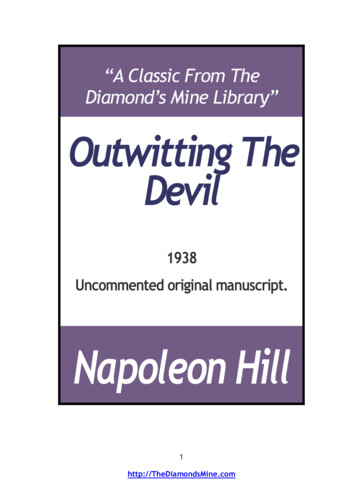
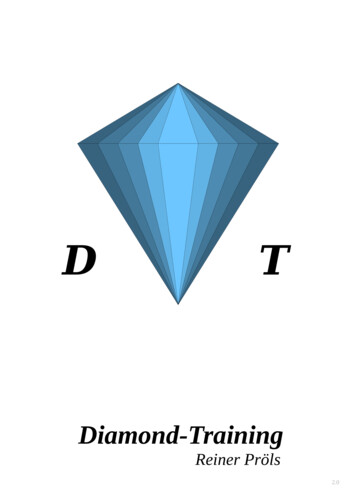



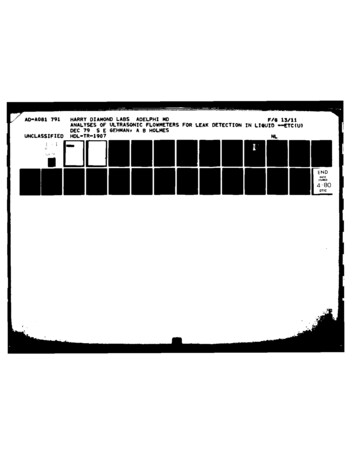
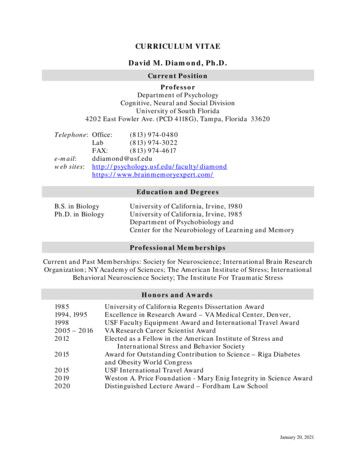
![Chess Transforming Care Tues PM Diamond B.ppt [Read-Only]](/img/11/transforming-care.jpg)

